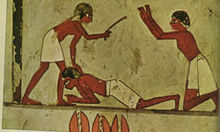
Back العبودية في مصر القديمة Arabic Esclavitud a l'antic Egipte Catalan Esclavitud en el antiguo Egipto Spanish Servitude dans l'Égypte antique French Escravidão no Antigo Egito Portuguese Рабство в Древнем Египте Russian Рабство в Стародавньому Єгипті Ukrainian
This article needs additional citations for verification. (July 2019) |

| Part of a series on |
| Slavery |
|---|
 |


Slavery in ancient Egypt existed at least since the Old Kingdom period. Discussions of slavery in Pharaonic Egypt are complicated by terminology used by the Egyptians to refer to different classes of servitude over the course of dynastic history. Interpretation of the textual evidence of classes of slaves in ancient Egypt has been difficult to differentiate by word usage alone.[1] There were three types of enslavement in Ancient Egypt: chattel slavery, bonded labor, and forced labor.[2][3][4] Even these seemingly well-differentiated types of slavery are susceptible to individual interpretation. Egypt's labor culture encompassed many people of various social ranks.
The word translated as "slave" from the Egyptian language does not neatly align with modern terms or traditional labor roles. The classifications of "servant," "peasant," and "slave" could describe different roles in different contexts. Egyptian texts refer to words 'bꜣk' and 'ḥm' that mean laborer or servant. Some Egyptian language refers to slave-like people as 'sqrw-ꜥnḫ', meaning "bound for life".[5] Forms of forced labor and servitude are seen throughout all of ancient Egypt. Egyptians wanted dominion over their kingdoms and would alter political and social ideas to benefit their economic state. The existence of slavery not only was profitable for ancient Egypt, but made it easier to keep power and stability of the kingdoms.[5][6]
- ^ Shaw, G. J. 2012. Slavery, Pharaonic Egypt. The Encyclopedia of Ancient History.
- ^ David, Rosalie (1 April 1998). The Ancient Egyptians (Beliefs & Practices). Sussex Academic Press. p. 91.
- ^ Everett, Susanne (24 October 2011). History of Slavery. Chartwell Books. pp. 10–11.
- ^ Dunn, Jimmy (24 October 2011). "Slaves and Slavery in Ancient Egypt". Retrieved 9 April 2016.
- ^ a b Loprieno, Antonio (21 November 2012). "Slavery and Servitude". UCLA Encyclopedia of Egyptology. 1 (1).
- ^ Cite error: The named reference
:1was invoked but never defined (see the help page).
© MMXXIII Rich X Search. We shall prevail. All rights reserved. Rich X Search